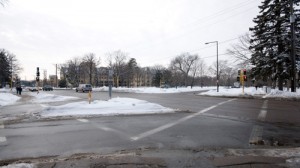
Parking Lot H will be closed in March in order for demolition of O’Shaughnessy Hall to take place. Some neighbors have raised concerns that with the Anderson Student Center going up, there will not be enough parking in the center of campus.
Some believe that pedestrian traffic between North and South campuses and traffic congestion at the intersection of Cretin and Summit avenues will increase. With enough parking under the student center, these neighbors wouldn’t be concerned.
“The criticism has been that we are not being realistic in terms of how many spaces we need on the main campus, underneath the student center,” said Doug Hennes, vice president of university and government relations.
The original plan for the Anderson Student Center included up to 150 underground parking spaces. In order to cut costs, that number has been brought down to 30.
“We eliminated 120 underground spaces at the student center site,” Hennes said. “So, the spaces, in all likelihood, will mostly be used as handicapped spaces and for guests. So, commuter students aren’t going to have access to those spaces for the most part as they’ve always had access to Lot H.”
Although the majority of the parking spaces have been taken out of the plan, Hennes said he is confident there is enough parking on campus to support the need.
Pedestrian management plan
“[The neighbors] know we’re going to have almost 2,600 parking spaces on campus … so we’ve got plenty of parking on campus,” Hennes said. “The question is where is it located.”
Hennes said the university acknowledges that when people park in the Anderson parking facility they are going to have to cross Cretin and Summit avenues in order to get to the new student center and that crossing those streets can be difficult.
To deal with some of the issues with crossing those streets, the university has developed a pedestrian management plan.
Each corner on Cretin and Summit avenues will have a larger staging area where people who are waiting to cross can stand. The southwest corner near Owens Science Hall and O’Shaughnessy Science Hall already has a large enough staging area, according to Hennes. Sidewalks may also be expanded so it’s easier to get people across the street.
The concrete island that allows vehicles a free right turn going west on Summit to turn north on Cretin will be taken out.
Another idea in the plan is to install what Hennes calls “bump outs.” That installation would shorten the distance to cross Summit and clearly defines where people can park so they don’t park too close to the corner. Hennes said that there may also be timing changes for the traffic lights and possibly added turn arrows for that intersection.
“We are going to improve the traffic flow both for pedestrians and, we believe, for cars so it will be easier for people to get back and forth,” Hennes said.
The goal is to do these renovations this summer, although the student center doesn’t open for two more years. But Hennes said the improvements are practical to make now.
The path between O’Shaughnessy Hall and Aquinas Hall will be closed when construction on O’Shaughnessy Hall begins. This may cause frustrations for some students who like to use that shortcut.
“It will definitely make it a lot harder for people to get to South Campus because they all have to go around,” junior Ryan Jorgensen said. “It will cause a bottleneck because everyone will have to go one way.”
Hennes said that the path in the median of Summit avenue between North and South campus will remain until the student center opens in January 2012. The university’s agreement with the city, according to Hennes, is that the median path will be removed, most likely in spring 2012, because it won’t be needed. The sidewalks outside the Anderson Student Center will lead directly to the northeast corner of Summit and Cretin avenues.
Junior Stephanie Renckens said she thinks the pedestrian management plan will be a good thing for the school.
“Genius. I know a lot of people jaywalk and just kind of ignore [the lights and signs],” Renckens said. “So I don’t know that there have been any incidents where someone has gotten hurt, but I mean there is definitely room for improvement.”
Stephani Bloomquist can be reached at slbloomquist@stthomas.edu.
